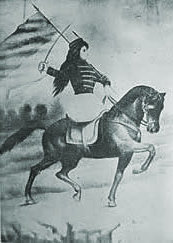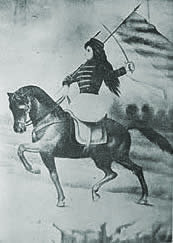
|
Women and Independence in Latin America An exploration of women's involvement in the Latin American Wars of Independence |

|

|
Women and Independence in Latin America An exploration of women's involvement in the Latin American Wars of Independence |

|
Gender:Female
Ethnic origen: White
Events:
| 1779 | - | Ouro Preto | - | Not applicable | - | She was born on 29 July 1779 in Ouro Preto. |
| 1830 | - | Ouro Preto | - | Not applicable | - | She was nominated to be a head teacher |
| 1838 | - | Rio de Janeiro | - | Not applicable | - | She died on 5 February 1868 . |
| 1839 | - | Ouro Preto | - | Not applicable | - | She got divorced |
| 1850 | - | Rio de Janeiro | - | Unknown | - | She lived most of her adult life here and this is where she published her work. |
| 1868 | - | Rio de Janeiro | - | Not applicable | - | She died on 5 February 1868 . |
Connections:
Education for girls (Brazil)Biography:
Born on 29 July 1779 in Ouro Preto (then Vila Rica and the capital of Minas Gerais), Brandão was the daughter of the sergeant-major Francisco Sanches Brandão and Isabel Feliciana Narcisa de Seixas. Biographers disagree regarding her marital status. Whilst Ignez Sabino states that she married a landholder at the behest of her parents and against her will (Sabino, 110), Eliane Vasconcellos quotes from another source which affirms that she was married to the captain Vicente Batista Rodrigues, from whom she applied for legal separation on 23 October 1832 on the grounds of abuse, but also notes that other biographers maintain that Brandão never married (Muzart, 82).
The formal education she received was limited to reading and music, but she also had the opportunity to learn French and Italian with a family friend, against the wishes of her father (Sabino, 107). Whilst still in Ouro Preto, Brandão opened and ran a school for girls, and was a member of the Sociedade Promotora da Instituição Pública da Cidade de Ouro Preto. She subsequently moved to Rio de Janeiro, where she continued to make a living as a governess. It was also in Rio where she initiated the literary career for which she is known, writing poetry and plays as well as translations from French and Italian and musical compositions. She also participated in the social and political life of the capital’s elite, attending the court salons and various literary and scientific gatherings where she read her poetry and performed her musical compositions.
The first of her poetry to be published appeared in 1831 in the second volume of Januário da Cunha Barbosa’s Parnaso Brasileiro and she later published these and other works in several collections of her own. She also contributed to the Carioca press, publishing in the Guanabara and the Marmota Fluminense, sometimes under the pseudonym of D. Beatriz. As well as the published texts listed below, she also translated a number of operas and wrote various poems in honour of the royal family, including one, “Lágrimas do Brasil”, which was inscribed on the monument erected in memory of Queen Estefánia. She also wrote two unpublished dramas to mark the coronation of D. Pedro I and the birth of D. Pedro II, both of which were set to music and performed in public. In 1850 various members of the Instituto Histórico e Geográfico Brasileiro suggested that Brandão should be made an honorary member. The decision fell to Joaquim Manoel de Macedo and Antônio Gonçalves Dias, who refused her admission on the stated grounds that her publications were not concerned with history or geography and that she should therefore seek membership of a Brazilian Literary Academy as and when such an association was created (Muzart, 84-5; Schumaher & Brazil, 100).
Brandão was a friend of the poet Delfina Benigna da Cunha and the journalist Violante Atabalipa Ximenes de Bivar e Velasco, dedicating work to both women. She may also have had a personal acquaintance with the Empress Teresa Cristina, to whom she bequeathed her manuscripts. She is also thought to have been the first cousin of Maria Dorotéia de Seixas, the “Marília” celebrated by the poet Tomas Antônio de Gonzaga in his famous work “Marília de Dirceu” (published in Lisbon in 1792) (Schumaher & Brazil, 99).
Brandão died in Rio on 5 February 1868 (Muzart, 85). (Sabino gives 1860 as the year of her death (Sabino, 110)).
As well as publishing various poems in Januário da Cunha Barbosa’s collection Parnaso brasileiro ou collecção das melhores poesias dos poetas do Brasil, tanto inéditas, como já impressas (Vol. 2, Caderno 5, pp. 27-38 and Caderno 7, pp. 7-28, Rio de Janeiro: Typ. Nacional, 1831), Brandão also published three collections of her own poetry and translation:
Cantos da mocidade, Rio de Janeiro: Emp. Typ. Dous de Dezembro, 1856
Romances imitados de Gessner, Rio de Janeiro: Typ. BXP de Sousa. Contains two short narratives in verse: “O Caçador” and “Lelia e Nerina”.
Catão, translated from the Italian, Rio de Janeiro: Typ. BXP de Sousa, 1860.
.
References:
Muzart, Zahidé Lupinacci (editor). (2000) Escritoras Brasileiras do Século XIX
Schumaher, Schuma and Brazil, Érico Vital (editor). (2000) Dicionário Mulheres do Brasil de 1500 até a atualidade
Blake, A V A Sacramento (1883) Diccionario Bibliographico Brazileiro
Sabino, Ignez (1899) Mulheres Illustres do Brazil